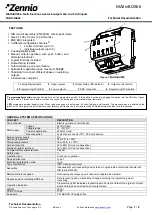
Functional Description
203
SLAU723A – October 2017 – Revised October 2018
Copyright © 2017–2018, Texas Instruments Incorporated
System Control
4.1.5 Clock Control
The system control module determines the control of clocks in this part.
4.1.5.1
Fundamental Clock Sources
Multiple clock sources are available for use in the microcontroller. The Run and Sleep Mode Configuration
(RSCLKCFG) register can be used to configure the required clock source for the device after POR, as well
as the system clock divisor encodings. The available clock sources are:
•
Precision Internal Oscillator (PIOSC)
The PIOSC is an on-chip clock source that the microcontroller uses during and following POR. The
PIOSC is the clock source in effect at the start of reset vector fetch and the start of code application
execution. The PIOSC does not require the use of any external components and provides a clock that
is 16 MHz ± f
PIOSC
across temperature (see the PIOSC specifications in the device-specific data sheet).
The PIOSC allows for a reduced system cost for applications in which a high-precision clock source is
not required. If the main oscillator is required, software must enable the main oscillator following reset
and allow the main oscillator to stabilize before changing the clock reference. If the Hibernation module
clock source is a 32.768-kHz oscillator, the PIOSC can be trimmed by software based on a reference
clock for increased accuracy. Regardless of whether or not the PIOSC is the source for the system
clock, the PIOSC can be configured to be an alternate clock source for some of the peripherals. See
for more information on peripherals that can use the PIOSC as an alternate clock.
•
Main Oscillator (MOSC)
The MOSC provides a frequency-accurate clock sourced by one of two means: an external single-
ended clock source is connected to the OSC0 input pin, or an external crystal is connected across the
OSC0 input and OSC1 output pins. If the PLL is being used, the frequency of the crystal can be 5 MHz
to 25 MHz (inclusive). See
for recommended crystal values and PLL register programming. If
the PLL is not being used, the frequency of the crystal can be 4 MHz to 25 MHz. The single-ended
clock source range is from DC through the specified speed of the microcontroller.
•
Low-Frequency Internal Oscillator (LFIOSC)
The LFIOSC provides a nominal frequency of 33 kHz with (see the device-specific data sheet for
specifications). The LFIOSC is intended for use during deep-sleep power-saving modes. This power-
savings mode provides reduced internal switching and the ability to power down the MOSC or PIOSC
while in deep-sleep mode through configuration of the Deep Sleep Clock Configuration (DSCLKCFG)
register.
•
Hibernation Module RTC Oscillator (RTCOSC) Clock Source
The Hibernation module provides a multiplexed output of two clocks to the System Control module: an
external 32.768-kHz clock or a low-frequency clock. The Hibernation module can be clocked by a
32.768-kHz oscillator connected to the XOSC0 pin. The 32.768-kHz oscillator can be used for the
system clock, thus eliminating the need for an additional crystal or oscillator. Alternatively, the
Hibernation module contains a low-frequency oscillator (HIB LFIOSC), which is intended to provide the
system with a real-time clock source and may also provide an accurate source of deep-sleep or
hibernate mode power savings. The HIB LFIOSC is a different clock source than the LFIOSC. See the
device-specific data sheet for more information on frequency range.
















































